
Chapter 9: The Human Body
The human body is an amazing, complicated machine. It doesn’t come with an instruction manual, but we know a lot about how the parts work and how to keep them running.
HOW does the body fight germs?
Germs are all around you. Most are harmless, but a few can make you sick. When bacteria, viruses, and other microorganisms (tiny one-celled life-forms) try to infect you, your immune system springs into action. To be immune is to be protected, and the immune system has several ways to fight germs and keep you healthy. The first line of defense is your skin, which keeps out germs. The natural openings in the body, such as the mouth and eyes, produce chemicals to kill germs. If germs do get through your outer defenses, they are attacked by different types of white blood cells.
When you are infected, you feel sick: glands in the neck or armpits get swollen and tender, your temperature rises, skin that is cut might get red and sore. These are signs that your body is battling the germs.

Chemicals in saliva and in tears fight bacteria.
The surface of the skin is full of dead cells, so germs can't get a foothold. The skin also produces chemicals that can kill some bacteria.
Mucus in the nose can trap germs.
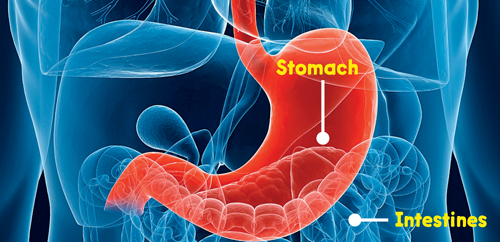
Stomach acid kills bacteria.
White blood cells, or lymphocytes, patrol the body, looking for germs to kill. There are three main types: Natural Killer (NK) cells, T cells, and B cells. NK cells can tell the difference between normal cells and cells infected by viruses or tumors. When they recognize invaders, they release granules that attack and kill the invading cells.

Human T and B cells identify pathogens and toxins. They produce memory cells that remember pathogens the body encounters, preparing the body for a strong response if any of those pathogens appear again. Memory cells are packed with mitochondria, which helps them live a long time.

Phagocytes are also white blood cells. They are prompted by lymphocytes to swallow and destroy invading cells.

KEEP HEALTHY
The immune system works hard to fight off germs and keep you healthy. But there are ways you can pitch in and help out your body’s defenses.
Get enough sleep. You should be getting nine to 10 hours of sleep every night.
Eat right. Try to eat three regular meals of nutritious foods that include fruits, vegetables, and whole grains. Avoid sugary foods and drinks, as well as fast food. Drink plenty of water.
Exercise. When you exercise, you strengthen your bones, muscles, and heart, and make the lungs work better.
Wash your hands regularly. Regular handwashing is the best way to stop germs from spreading. Wash with warm water and soap for 20 seconds—the time it takes to sing “Happy Birthday.”
Reduce stress. Too much stress over a long period of time can weaken the immune system. Talk over your problems with your parents or teachers. To reduce stress, you can exercise, enjoy hobbies, read for pleasure, or play with a pet.
HOW do wounds heal?
You and your friends are having a blast, but then—whammo!—you fall and cut your knee. Almost immediately, your body leaps into action. A series of fortunate events takes place to stop the cut from bleeding and allow the healing to begin (on the following pages).
1. CALL TO ACTION! First, the blood vessels around the wound tighten to slow the bleeding. Next, damaged cells within the blood vessels release chemicals that bring platelets to the scene of the injury. Platelets are disk-shaped cells present throughout the blood. The platelets stick together in layers to form a blood clot, or plug, for the wound.

2. The clot helps keep bacteria out and stop blood loss. A protein called fibrin is activated. Fibrin is stringy and flexible. It forms a blood-stopping mesh over the cut.
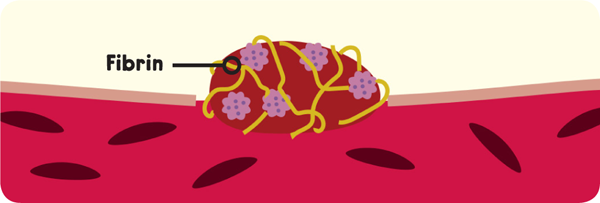
3. REPAIR WORK! Once the clot has formed, blood vessels open wide so nutrients and oxygen can reach the site of the injury quickly. This widening causes inflammation, or swelling, around the wound. At the same time, white blood cells called macrophages work to fight off infection, stimulate cell growth, and repair the wound.
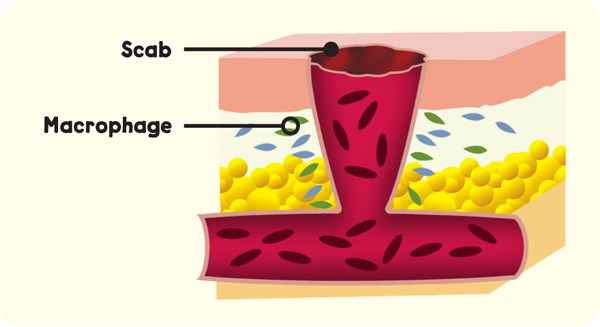
4. TIME TO REBUILD! Fibroblast cells produce a fiberlike protein called collagen. Collagen acts like scaffolding, or a temporary framework, during cell growth. The collagen fibers are cross-linked over one another until they form a stable scar. During this phase, cells on the outer layer of skin also divide to form new skin. Over time, the collagen rearranges itself to look as it did before, but if the wound was big enough, a scar will remain.

HOW TO HELP A WOUND HEAL
If you or a friend is injured, always have an adult administer first aid. If you fall on the playground, see the school nurse. If you topple off your bike in the driveway and scrape your knees, let your parents know. And if a wound is severe, get medical attention right away.
Here are some first aid tips for treating cuts and scrapes.
• Wash hands before touching the injured area, to help prevent infection.
• If bleeding does not stop on its own, apply gentle pressure with a clean cloth and elevate the wound.
• Rinse the wound with water. Clean the area around it with soap and a fresh washcloth. If debris—a splinter, for example—is in the wound, show an adult. He or she may sterilize tweezers with alcohol and gently remove the debris, or you may need to see a doctor.
• Apply antibiotic ointment.
• Cover the wound with a sterile adhesive bandage.
DEEP TROUBLE Sometimes a deep or dirty wound calls for a tetanus shot. Tetanus is a rare but serious disease caused when certain bacteria, Clostridium tetani, enter a wound. These bacteria are commonly found in soil, manure, and dust. If you work around animals and are injured, your doctor may recommend a tetanus shot in addition to treating the wound itself. The best way to avoid tetanus is to get regular vaccinations.

Watch out for rusty nails and splinters.
.png)
Tetanus shot Kids and adults get vaccines to protect against tetanus.
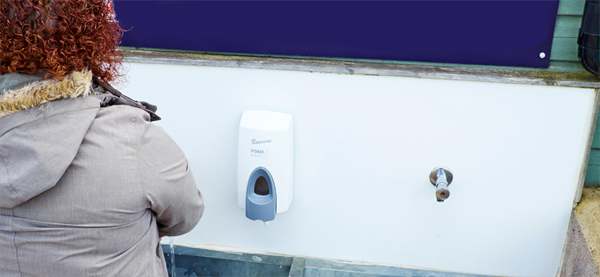
Hand washing Help protect against tetanus and other diseases by keeping your hands clean.
Did You Know?
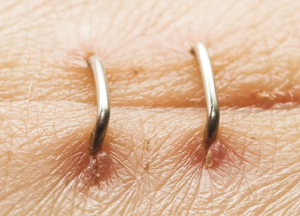
Surgical staples at work
A deep or jagged wound that exposes the muscle tissue will require stitches to close properly. In the past, these injuries were sewn closed with medical thread. Today, doctors can also use staples or a special type of surgical glue known as liquid stitches.
HOW do medicines work?
When you’re feeling sick, you might need to see a doctor. After you tell the doctor what’s wrong, the doctor will examine you. He or she will look into your eyes, nose, and throat, listen to your heartbeat and lungs, and take your blood pressure. Armed with information, the doctor will offer a diagnosis—the reason why you are sick—and give a treatment. Often that treatment is some kind of medicine.
A medicine is a specific chemical that treats your illness. It can be a liquid, tablet, or capsule you swallow. Liquids can also be injected with a needle right into the bloodstream. Creams or ointments are absorbed through the skin. Fluids can be dropped into the eyes or ears. Inhalers spray drugs into the nose or throat. Drugs can fight an illness, prevent an illness, or make the symptoms of an illness less strong.

DISEASE FIGHTERS An antibiotic kills bacteria or keeps them from multiplying. Bacteria (shown here greatly magnified) are germs that can sometimes cause disease. Certain drugs also kill other types of microorganisms that can lead to disease, such as fungi and parasites. Medicine can also target cells that aren’t working normally, such as cancer cells.

BE PREPARED A vaccine is made of a dead or weakened part of a germ, such as a flu virus. When a vaccine is injected into a person, the body reacts by building up defenses against that particular germ. If that type of germ one day tries to infect the person, the body will be ready to attack it right away.

PAINKILLERS Painkillers like aspirin can make you feel better while your body heals. If a part of the body is injured, nerve endings send pain signals to the brain. The drugs interfere with the message, so the pain stops.
REPLACEMENTS Sometimes the body doesn’t produce enough, or any, of a substance. Drugs can be used to replace those substances. For example, a person with a disease called diabetes gets extra insulin to stay healthy from an insulin shot. The shot comes in an insulin kit like the one in the photo.

THE MOLD THAT CHANGED HISTORY
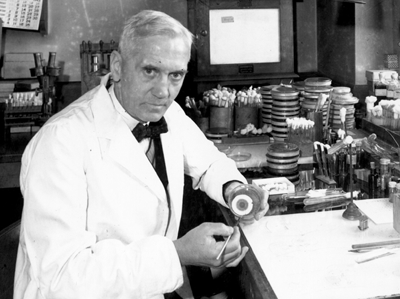
When Dr. Alexander Fleming returned from vacation in September of 1928, he found a messy laboratory—and a revolution in medicine. A mold called Penicillium notatum had started growing in his petri dishes. It was preventing bacteria called staphylococci from growing.
Dr. Fleming wrote: “When I woke up just after dawn on September 28, 1928, I certainly didn’t plan to revolutionize all medicine by discovering the world’s first antibiotic, or bacteria killer. But I guess that was exactly what I did.”
The story didn’t end there. Ten years later, Dr. Howard Florey, who was also studying uses for bacteria and mold, learned of Fleming’s work. He began experimenting with fluid extracted from the mold. The penicillin, as it was called, cured infections in mice. He tried it on a human patient in 1940, who began to recover. Unfortunately, he didn’t have enough penicillin to save the patient.
After considerable research, in 1941, scientists determined how to produce penicillin in large quantities. During World War I, 18% of wounded soldiers died of infection. In World War II, that number dropped to just 1%. Penicillin had changed history.
HOW does the stomach digest food?
If you gulp down too much pizza too quickly, your stomach will expand. Nerve endings in your belly tell your brain, “You’re full. Stop eating!” And you do—after having that one last slice. But what is happening to the pizza you’ve eaten?
The slices are taking a long journey through the digestive system. After you swallow, the food goes down a tube called the esophagus (es-ahf-a-gus). The pizza then makes a pit stop in the stomach. The stomach is a muscular bag that crushes the food and churns it in a strong acid until the pizza turns into a souplike liquid called chyme (kime). The chyme sits in the stomach for two to six hours, until it’s ready to move on to the intestines and out the other end.
Check out how food gets broken down in the stomach (and learn why the stomach doesn’t digest itself).

MUCOUS CELLS These cells produce mucus, a thick liquid that coats the stomach lining and keeps the hydrochloric acid from touching it. The cells also produce bicarbonate. When this chemical mixes with the mucus, it turns the acid into water. Even if the stomach does get damaged by the acid, every cell in the lining is replaced every week.
PEPSIN CELLS They produce a chemical called pepsin, which breaks down proteins and carbohydrates in food.
ACID CELLS These cells make hydrochloric acid, which turns food into liquid. Hydrochloric acid is strong enough to dissolve wood and even some metals. Too much of this can irritate the stomach lining.
GASTRIC GLANDS Hydrochloric acid and pepsin mix in narrow tubes called gastric glands.
GASTRIC PITS The mix of hydrochloric acid and pepsin flows out of the gastric glands and into the stomach through millions of tiny holes called gastric pits.
THE ECOSYSTEM INSIDE YOU Our digestive system is packed with 100 trillion microbes, most of them friendly bacteria living in the small and large intestines. They feed off the food we eat and crowd our intestines, preventing bad invader microbes from moving in.
Gut bacteria produce enzymes that help the body break down substances that our bodies alone could not digest, such as fiber and some starches and sugars. Most of the nutritional value of vegetables and fruits would be wasted without these bacteria. Certain bacteria also produce vitamin B12 and vitamin K, which are absorbed by the body.
Muscles in the digestive system move food down in a wave of automatic contractions. What was once a meal becomes a mass of undigested food called feces (fees-ease), along with a lot of living and dead bacteria. About half the feces is made of bacteria, which give feces its brown color.

HOW does exercise build strong muscles?
The human body contains more than 600 muscles. Together, they make up about one-third of your body weight. Muscles have different tasks. Cardiac muscle pumps the heart. Smooth muscle supports blood vessels and organs such as the stomach, intestines, and bladder. Skeletal muscle holds you up and gets you moving.
To lift the arm, some muscles will contract, or shorten, and others will relax, or lengthen. Skeletal muscles come in pairs. As you curl your arm, for instance, the biceps muscle on the top of your upper arm contracts, while the triceps muscle on the underside relaxes. When you straighten your arm, the biceps muscle relaxes and the triceps muscle contracts.
MUSCLE ANATOMY

Myosin and actin filaments move over one another during muscle contraction.
Skeletal muscles are made up of bundles of cell fibers.
Skeletal muscle fibers are filled with protein filaments (threadlike groups of cells).
PAIRED MUSCLES
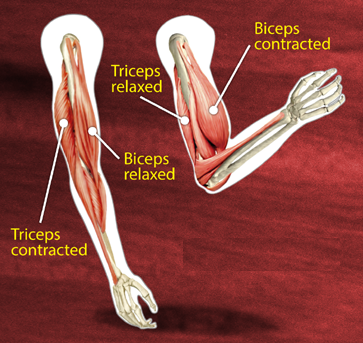
GOOD STRESS Exercises that use resistance bands, as well as sit-ups, chin-ups, and push-ups, are good ways to build muscle strength. When your muscles strain during exercise, the stress on them causes microscopic tears in the muscle. As your body repairs the damage, the result is muscle growth. Not all muscle stress is good, so always consult with a parent or doctor before starting an exercise program.

BE ACTIVE AND PLAY OUTDOORS Climbing uses different muscle groups and builds strength. Activities like running, biking, and dancing help you grow stronger, too. Exercise has another benefit. Stress to the bone plates at the end of bones stimulates growth. Why play outdoors? It’s fun! And vitamin D (which your body manufactures using sunlight) helps build strong bones, which are important to physical fitness. Wear sunscreen to avoid skin damage.

HOW do eyeglasses help you see better?
The eye is an amazing and complicated organ that starts working when light passes through the cornea. The cornea is a clear shield over the eye that focuses light. After the light enters a small opening called the pupil, the lens focuses it again, but this time onto the retina at the back of the eye, where an image appears upside down. The retina is covered by cells that are sensitive to light. When the light hits the retina, the cells send electric signals to the brain. The brain unscrambles the signals to make the right-side-up image that we see.
You may take vision for granted, but eyes don’t always work perfectly. Some people have trouble seeing near or far objects clearly. If things are blurry, they may need glasses or contact lenses. When they put them on or in, the world comes back into focus.
THE EYES HAVE IT To make sure your eyes stay healthy, follow these tips.
• Eat five servings of fruits and vegetables every day. Nutrients in foods such as oranges, broccoli, corn, carrots, and green, leafy vegetables will help keep your peepers perfect.
• Get plenty of exercise. Physical activity gets the blood moving, delivering more oxygen and nutrients to your eyes. But be sure to protect your eyes with goggles if you play contact sports.
• When on the computer, look away for 20 seconds every 20 minutes to avoid eyestrain. Don’t sit too close to the screen. Your eyes should be about two feet away.
• Get an eye exam by a doctor at least once every two years.
FOCUS ON THE EYES Eyeglasses and contact lenses can help correct different vision problems that affect how we see things.

FARSIGHTED A farsighted person can see objects at a distance clearly. Things that are close look fuzzy because either the eyeball is too short or the cornea is too flat. Light from near objects is focused behind the retina, not on it. Glasses or contact lenses that correct this are convex, which means they curve out slightly. This spreads the light apart and focuses it on the retina.

NEARSIGHTED A nearsighted person sees close objects clearly. Objects that are far away are blurry because the eyeball is too long or the cornea curves too much. The light from distant objects is focused in front of the retina. Glasses or contact lenses that correct this are concave, meaning they curve in slightly. This bends the light inward and focuses it on the retina.

ASTIGMATISM A person with astigmatism (ah-stig-ma-tiz-im) may see objects both near and far out of focus. Most people's corneas are shaped like baseballs. A person with astigmatism has a cornea that looks more like a football. Light scatters, focusing on different areas of the retina. This makes objects seem wavy. To correct this problem, glasses or contact lenses focus light on the same area of the retina.
Fast Fact

Nearsightedness is on the rise. By the end of the decade, more than one-third of people in the world will be nearsighted. Researchers think one reason for this increase is that kids don’t spend as much time outdoors compared to children in the past. Less exposure to sunlight is linked to nearsightedness. In East Asia, where students spend at least 14 hours per week doing homework, 90% of young adults are nearsighted. In response, governments have launched public health campaigns to encourage outside activity.
HOW do braces straighten teeth?
Crooked teeth are an inherited trait, just like hair and eye color. Thumb sucking or the overuse of bottles and pacifiers can also cause teeth to grow in the wrong direction. Fortunately, braces can straighten out a crooked smile.
Straightening teeth isn’t just about looks. Crooked teeth can cause problems with eating or talking. They may lead to gum disease, because gaps between teeth give bacteria room to grow, while crowded teeth leave too little room to brush properly. When top and bottom teeth rub together, they can wear down quickly.
THE FORCE IS WITH . . . BRACES

Chewing puts (literally) tons of pressure on teeth. Stretchy, connective bands called ligaments protect teeth from chewing forces by acting as shock absorbers. When you bite down on something hard, special receptor cells in the ligaments tell the brain to stop chewing so your teeth aren’t damaged.
Braces apply a steady force to teeth, slowly pulling them apart or pushing them together until they’re evenly spaced. When the receptor cells (called mechanoreceptors) feel this pressure, they activate bone cells (called osteoclasts), which release acids and proteins to dissolve parts of the jawbone.
Next, the mechanoreceptors activate different bone cells, known as osteoblasts. These cells deposit minerals to form new bone and rebuild the jaw.
GETTING BRACES If your teeth are crooked and need to be straightened, the dentist will recommend you see a special dentist called an orthodontist.

FIRST The orthodontist takes photos, molds, and X-rays of the teeth to decide the best way to fit the braces.

THEN Bonding glue is applied to teeth to secure teeth brackets. Arch wire, which guides the teeth, is added. Tiny rubber bands on each bracket hold the wire in place. During regular visits, the orthodontist will check the progress and may adjust the wires and bands.

SECOND The orthodontist cleans and dries the teeth. He or she assembles the materials, which include brackets, arch wires, and bands.


FINALLY After braces come off, a removable retainer is made to fit over the teeth. The retainer holds the straightened teeth in place and prevents them from slipping back into their old positions. Sometimes a retainer is used on its own to realign teeth.
Fast Fact
Tooth enamel is like tooth armor. It is the hardest biological material there is—harder than bone, and harder even than steel. But it’s brittle, which is why teeth can chip.
Did You Know?

It varies from person to person, but on average braces take one to three years to straighten teeth.
HOW TO grow salad on a windowsill

Greens are good, and good for you. They form an important part of a balanced diet. And leafy greens grow well indoors, even in winter: try butterhead, romaine, baby oakleaf, or other lettuce varieties, or plant spinach or herbs.
You don’t need lots of land to grow your own salad greens. All you need is a sunny window, a pot, a growing medium such as potting soil, and seeds. You’ll be harvesting your own salads in no time!
What you need:

• Long, slim container that fits on a windowsill (the container should have holes for drainage and a tray to catch water runoff)
• Nutrient-rich potting soil, compost, or seed-starting mix
• Salad seeds
• Small trowel (a sturdy spoon will work, too)
• Watering can and mister
What to do:
1. Place your container on a windowsill. South-facing windows usually get the best light.

2. Fill the pot with soil to half an inch from the top. Don't tamp or press it down.

3. Create ruts a quarter of an inch deep and two inches apart. Sprinkle seeds along the ruts. Cover loosely with soil.
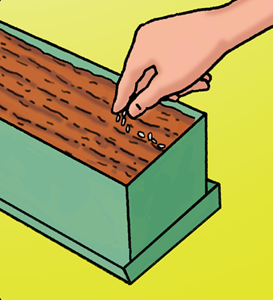
4. Water regularly, so the soil stays moist. To test whether it's time to water your seeds, stick a finger into the soil. If the soil feels dry, add water.
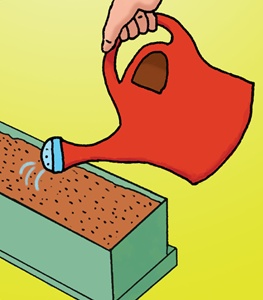
5. After the plants have sprouted, spray the soil with a mister to keep it moist, but not soaking. Seedlings should be one inch apart. If they’re too crowded, remove some of the plants.

6. Once your lettuce reaches two to four inches in height, cut the outer leaves approximately one inch above the soil. New leaves will grow and be ready to harvest about two weeks later.
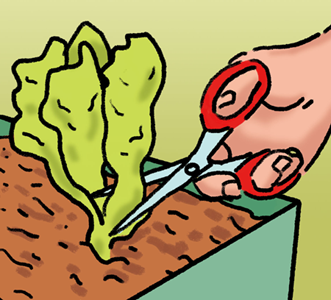
GOOD AND GOOD FOR YOU You can expand your windowsill garden and grow a mix of tasty, healthy foods. Here are some other things you can grow.
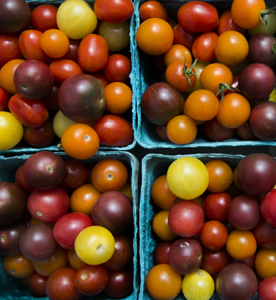
Tomatoes, green leafy vegetables, and peppers are packed with vitamin C, which boosts the immune system and helps wounds heal.

Carrots contain vitamin A, which protects the skin and digestive tract and prevents infection.

Radishes are good sources of fiber, which aids digestion, produces good bacteria in the gut, and helps remove toxins during elimination.